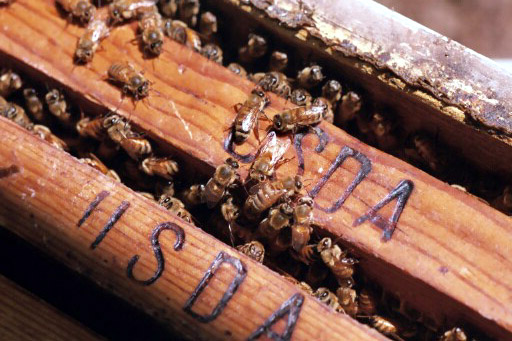By KELLY vanFRANKENHUYZEN
Capital News Service
LANSING — Urban beekeeping is an increasingly popular teaching tool that also provides support for the threatened pollinators.
“Rooftops and balconies are great places for beehives in the city because the bees will fly above everyone,” said Meghan Milbrath, the coordinator of the Michigan Pollinator Initiative Project.

Urban beekeeping is on the rise, a trend that could help bees and educate people. Image: U.S. Department of Agriculture.
Her program at Michigan State University addresses bee health and pollination across the state.
Milbrath coordinates the care of beehives at the Student Organic Farm and the Bailey Greenhouse and Urban Farm at the university. Two hives were installed on a dorm balcony last spring.
The installation was not without controversy.
“Four hundred students are living in this dorm,” said Laurie Thorp, director of the university’s Residential Initiative on the Study of the Environment, the group that manages the urban farm.
That raised concern with parents, students and staff.
“Parents were nervous about bee allergy reactions,” Thorp said. Other worries included whether the smoker used to calm the bees could set off a fire alarm, if the bees were perceived as “killer bees” and if dorm staff would have to be trained to administer injections if someone got stung.
It’s a common problem. Many beekeepers say the public is uninformed about bees. But urban hives provide opportunities to deliver education and information.
“Bee education is in demand” at the University of Minnesota, said Rebecca Masterman, the associate director and coordinator of the Bee Squad, a group that helps beekeepers raise healthy bees in the Twin Cities area.
“Providing educational programs and events for various age groups is one of our challenges,” Masterman said. The group supports organizations that teach kids about bees.
The Bee Squad manages hives on the roofs of the Minneapolis Institute of Arts and the Weisman Art Museum in Minneapolis.
Urban beekeeping is costly and time-consuming, Masterman said. A colony of bees and their housing costs about $550.
The Bee Lab at the University of Minnesota offers two to three eight-hour classes a year with about 250 students enrolled for each offering.
And the Bee Squad, which is an outreach arm of the lab, offers hands-on mentoring classes for no more than six people at a time.
“It’s a manageable way to train people in basic beekeeping,” Masterman said.
Finding such hands-on training is important, bee experts say.
“City beekeepers are newer to the craft and more likely to be self-educated,” columnist Toni Burnham wrote in Bee Culture Magazine.
But while searching the Internet may be faster, cheaper and easier, it isn’t sufficient.
“It is not great preparation for the unexpected, which biology and the bees are never short on delivering,” Burnham wrote.
Bees are great for delivering environmental education, some educators say. For example, a middle school in Madison, Wisconsin, received a grant for two hives from Growing Power, a nonprofit urban agriculture organization that teaches people about the importance of food systems.
“No bees means no food,” said Robert Pierce, manager at Growing Power-Madison, who emphasizes the importance of bees as pollinators and the food systems they support.
Among the barriers are the challenges the bees face themselves.
Masterman of the University of Minnesota said bee parasites like varroa mites are a global problem, and they are the number- one challenge for urban beekeepers in the Twin Cities area.
Other challenges include pesticides, particularly those used by homeowners who may not be as well-trained in their use as farmers and other professionals, she said.
MSU’s Milbrath has more than 100 urban and rural hives in Central and Southeast Michigan including Ann Arbor and East Lansing. All those nearby lawns represent an opportunity to further support the bees. She said she hopes the near future that stores will sell an ornamental plant mix for lawns to increase pollination.
“Bees use an enormous amount of food sources from lawns in urban areas,” she said.
Kelly vanFrankenhuyzen writes for Great Lakes Echo.